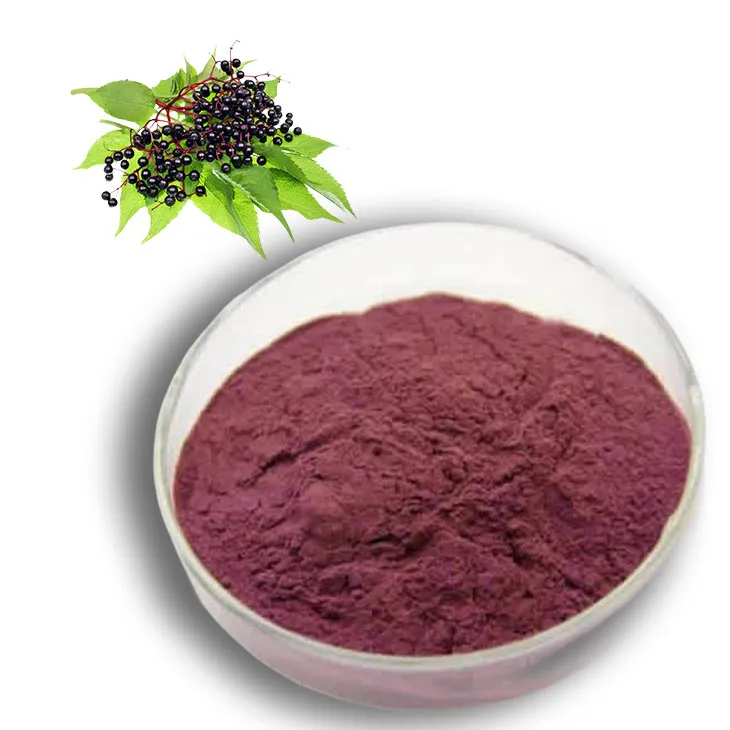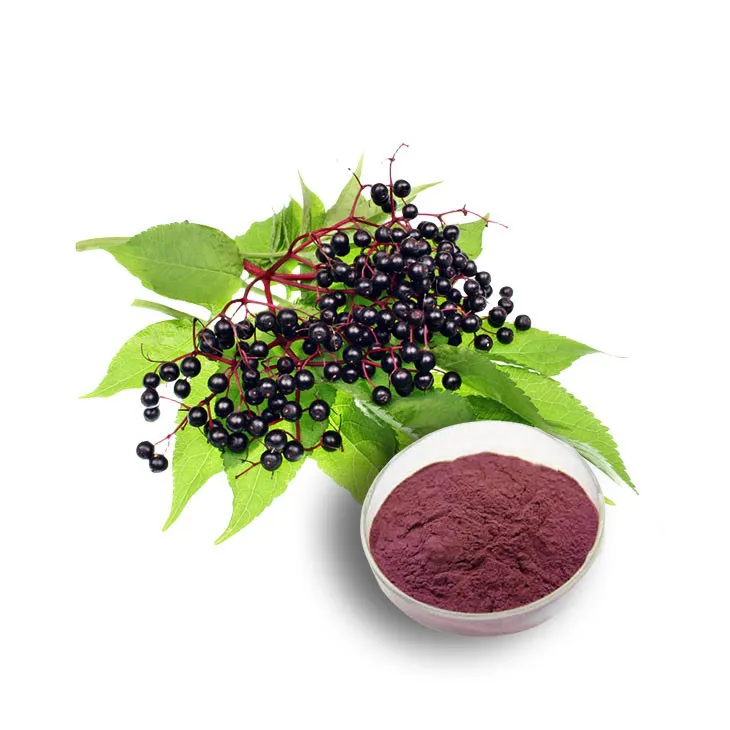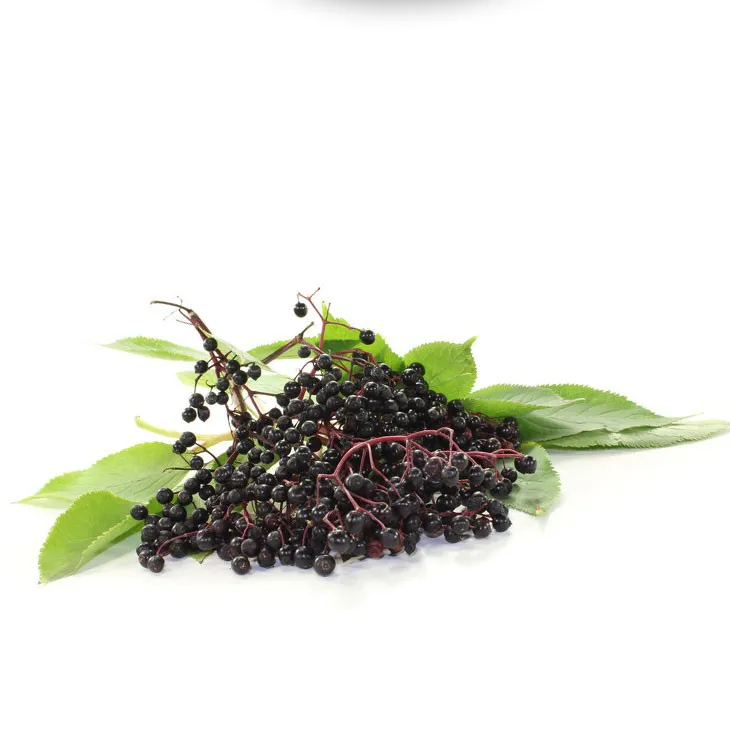- 0086-571-85302990
- sales@greenskybio.com
Elderberry Extract: From Leaves to Extraction.
2024-11-12

1. Introduction to Elderberry
The elderberry, scientifically known as Sambucus, is a plant that has been part of human history for centuries. It is a deciduous shrub or small tree that can be found in various parts of the world, including Europe, North America, and Asia. Elderberries are small, dark - purple berries that grow in clusters. However, it's not just the berries that are of interest; the leaves of the elderberry plant also hold significant potential.

2. The Elderberry Leaf
2.1 Physical Characteristics
Elderberry leaves are typically pinnate, which means they are composed of multiple leaflets arranged on either side of a central stalk. The leaflets are usually lance - shaped, with serrated edges. They are green in color during the growing season and may turn yellow or brown in the fall.
2.2 Chemical Composition
Elderberry leaves contain a variety of chemical compounds. These include flavonoids such as Quercetin, kaempferol, and rutin. Flavonoids are known for their antioxidant properties. They also contain phenolic acids like chlorogenic acid, which has been studied for its potential health - promoting effects. Additionally, the leaves may have small amounts of alkaloids and tannins.
3. The Extraction Process
3.1 Harvesting
The first step in the extraction of Elderberry Extract from leaves is harvesting. Elderberry leaves are usually harvested during the growing season when they are at their peak of freshness and nutrient content. It is important to select healthy leaves from plants that are free from diseases and pests.
3.2 Drying
Once harvested, the leaves need to be dried. Drying helps to reduce the moisture content of the leaves, which is essential for the extraction process. The leaves can be dried naturally in a well - ventilated area or using artificial drying methods such as dehydrators. Proper drying ensures that the leaves do not spoil during storage and also helps in concentrating the active compounds.
3.3 Grinding
After drying, the elderberry leaves are ground into a fine powder. Grinding increases the surface area of the leaves, which allows for more efficient extraction. The powder can be obtained using a mortar and pestle for small - scale extraction or using industrial - grade grinders for large - scale production.
3.4 Extraction Methods
-
3.4.1 Solvent Extraction
Solvent extraction is one of the most common methods used for elderberry leaf extract. A solvent such as ethanol or water - ethanol mixtures is used. The ground elderberry leaf powder is mixed with the solvent in a suitable container. The mixture is then agitated, either by shaking or using mechanical stirrers. This allows the active compounds in the leaves to dissolve into the solvent. After a certain period of time, the mixture is filtered to separate the liquid extract from the solid residue. -
3.4.2 Supercritical Fluid Extraction
Supercritical fluid extraction is a more advanced method. In this process, a supercritical fluid, usually carbon dioxide, is used as the extracting agent. Supercritical carbon dioxide has properties between a gas and a liquid. It can penetrate the plant material effectively and extract the desired compounds. This method has the advantage of being more selective and can produce a purer extract compared to solvent extraction. However, it requires more specialized equipment and is more expensive.

4. Unique Properties of Elderberry Extract
4.1 Antioxidant Properties
Elderberry Extract, whether from the berries or the leaves, is rich in antioxidants. Antioxidants play a crucial role in protecting the body against oxidative stress. Oxidative stress is caused by an imbalance between free radicals and antioxidants in the body. Free radicals are unstable molecules that can damage cells and contribute to various diseases such as cancer, heart disease, and neurodegenerative disorders. The flavonoids and phenolic acids in elderberry extract can scavenge free radicals, thereby reducing oxidative stress.
4.2 Anti - inflammatory Effects
Studies have shown that elderberry extract may have anti - inflammatory properties. Inflammation is a natural response of the body to injury or infection, but chronic inflammation can lead to many health problems. The compounds in elderberry extract can inhibit the production of inflammatory mediators such as cytokines and prostaglandins. This can help in reducing inflammation in the body, potentially providing relief in conditions such as arthritis and inflammatory bowel disease.5. Potential Health Benefits
5.1 Immune System Support
Elderberry extract is often touted for its ability to support the immune system. It can stimulate the production of immune cells such as white blood cells. This may help the body to fight off infections more effectively. Some studies have suggested that elderberry extract may be particularly useful in preventing and treating upper respiratory tract infections, such as the common cold and influenza.
5.2 Cardiovascular Health
The antioxidant and anti - inflammatory properties of elderberry extract can also have a positive impact on cardiovascular health. By reducing oxidative stress and inflammation, it may help in preventing the development of atherosclerosis, a condition in which plaque builds up in the arteries. This can reduce the risk of heart attacks and strokes.
5.3 Skin Health
Applied topically, elderberry extract may have benefits for skin health. The antioxidants in the extract can protect the skin from damage caused by free radicals from environmental factors such as UV radiation and pollution. It may also help in reducing inflammation in the skin, which can be beneficial for conditions such as acne, eczema, and psoriasis.6. Popularity in Various Fields
6.1 In the Food and Beverage Industry
Elderberry extract is increasingly being used in the food and beverage industry. It can be added to juices, smoothies, and other beverages to enhance their flavor and nutritional value. In the food industry, it can be used in the production of jams, jellies, and confectionery products. The antioxidant properties of elderberry extract also make it a popular ingredient for functional foods, which are designed to provide additional health benefits beyond basic nutrition.
6.2 In the Pharmaceutical and Nutraceutical Industry
In the pharmaceutical and nutraceutical industries, elderberry extract is being studied for its potential therapeutic applications. It may be developed into dietary supplements, either in the form of capsules, tablets, or tinctures. Some companies are also researching the use of elderberry extract in the development of new drugs for treating various diseases, based on its immune - modulating and anti - inflammatory properties.
6.3 In the Cosmetic Industry
The cosmetic industry has also recognized the potential of elderberry extract. It is being incorporated into skincare products such as creams, lotions, and serums. The antioxidant and anti - inflammatory properties of the extract make it suitable for anti - aging and skin - repair products. It can also be used in haircare products, potentially improving the health and appearance of the hair.7. Conclusion
Elderberry extract, obtained from the leaves through a series of well - defined processes, holds great promise in terms of its unique properties and potential health benefits. Its popularity is growing in various fields, from food and beverage to pharmaceuticals and cosmetics. As research continues, we can expect to learn more about this natural extract and its many applications, further expanding its use in improving human health and well - being.
FAQ:
What are the main components in elderberry leaves?
Elderberry leaves contain various components. They have flavonoids, phenolic acids, and other phytochemicals. Flavonoids like rutin are present, which contribute to antioxidant properties. Phenolic acids also play a role in the overall chemical profile of the leaves, potentially having implications for health.
How is elderberry extract obtained from the leaves?
The extraction process typically involves several steps. First, the elderberry leaves are carefully collected. Then, they can be dried to preserve their components. After that, solvents such as ethanol or water are often used. The leaves are soaked in the solvent, which helps to dissolve the active compounds. Through filtration and concentration processes, the extract is obtained, removing the solvent and leaving behind the concentrated active substances.
What are the potential health benefits of elderberry extract?
Elderberry extract may have several potential health benefits. It is known for its antioxidant properties, which can help combat oxidative stress in the body. It may also have anti - inflammatory effects, potentially reducing inflammation. Some studies suggest it could support the immune system, helping the body to fight off infections more effectively. Additionally, it may have benefits for heart health, such as helping to regulate blood pressure and cholesterol levels.
Why is elderberry extract becoming popular in different fields?
There are multiple reasons for its growing popularity. In the health and wellness field, the potential health benefits mentioned above make it attractive. In the cosmetic industry, its antioxidant properties can be useful for anti - aging products. In the food and beverage industry, it can be used as a natural flavor enhancer and also due to its potential health - promoting properties. Moreover, the trend towards natural products has also contributed to its popularity.
Are there any side effects of elderberry extract?
While elderberry extract is generally considered safe for most people, there can be some side effects. Some individuals may experience allergic reactions, especially those who are allergic to other plants in the same family. Also, if consumed in large amounts, it may cause gastrointestinal discomfort such as nausea, vomiting, or diarrhea. Pregnant and breastfeeding women should be cautious and consult a healthcare provider before using elderberry extract.
Related literature
- Elderberry: Botany, Horticulture, and Pharmacology"
- "The Chemical Composition and Biological Activities of Elderberry (Sambucus nigra L.)"
- "Elderberry Extract: A Review of its Production, Properties, and Potential Applications"
- ▶ Hesperidin
- ▶ Citrus Bioflavonoids
- ▶ Plant Extract
- ▶ lycopene
- ▶ Diosmin
- ▶ Grape seed extract
- ▶ Sea buckthorn Juice Powder
- ▶ Fruit Juice Powder
- ▶ Hops Extract
- ▶ Artichoke Extract
- ▶ Mushroom extract
- ▶ Astaxanthin
- ▶ Green Tea Extract
- ▶ Curcumin
- ▶ Horse Chestnut Extract
- ▶ Other Product
- ▶ Boswellia Serrata Extract
- ▶ Resveratrol
- ▶ Marigold Extract
- ▶ Grape Leaf Extract
- ▶ New Product
- ▶ Aminolevulinic acid
- ▶ Cranberry Extract
- ▶ Red Yeast Rice
- ▶ Red Wine Extract
-
Sugarcane Extract
2024-11-12
-
Acai Berry Extract
2024-11-12
-
Aminolevulinic acid
2024-11-12
-
Acerola Juice Powder
2024-11-12
-
Cranberry Extract
2024-11-12
-
Grape Leaf Extract
2024-11-12
-
Alisma Extract
2024-11-12
-
Alfalfa Meal
2024-11-12
-
Almond Extract Powder
2024-11-12
-
Reishi mushroom extract
2024-11-12





















